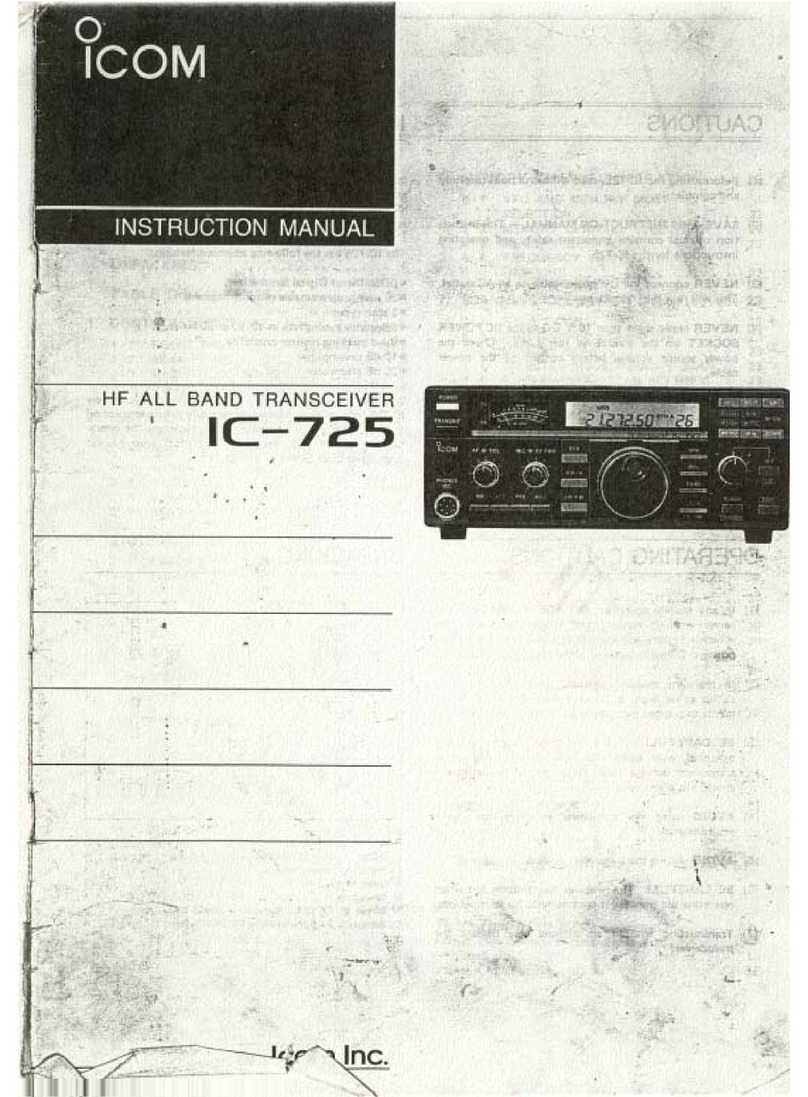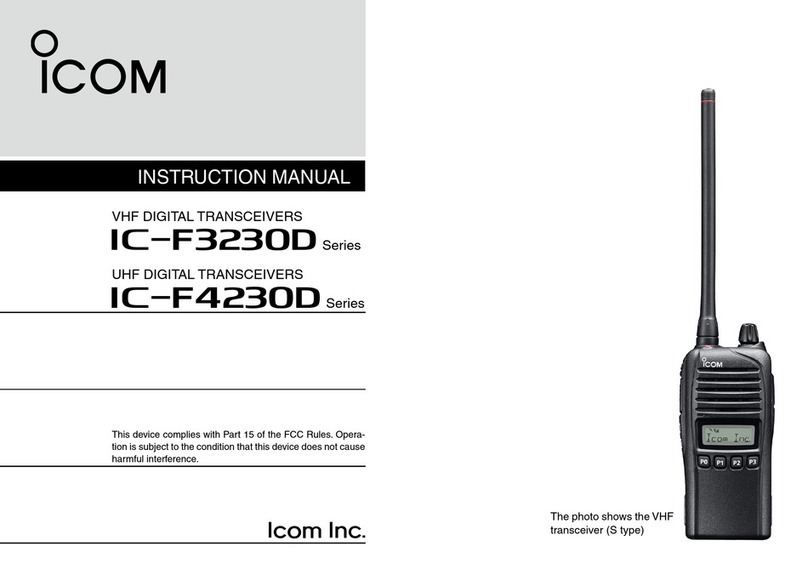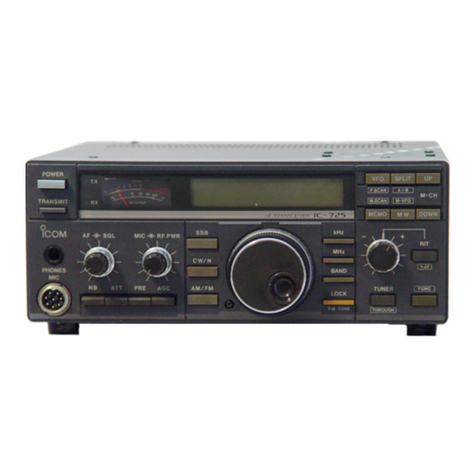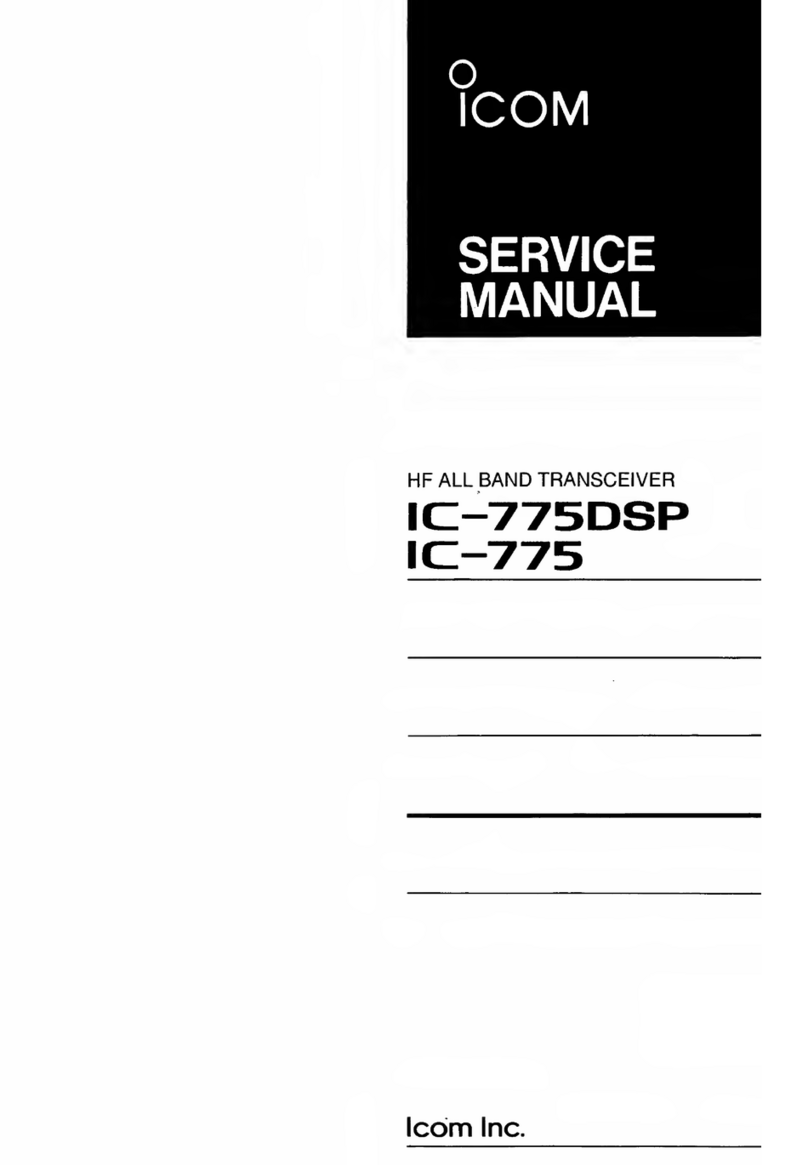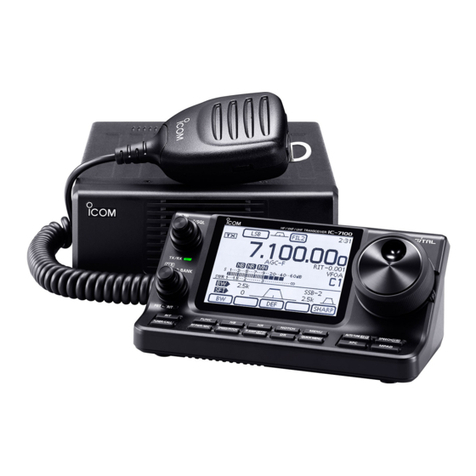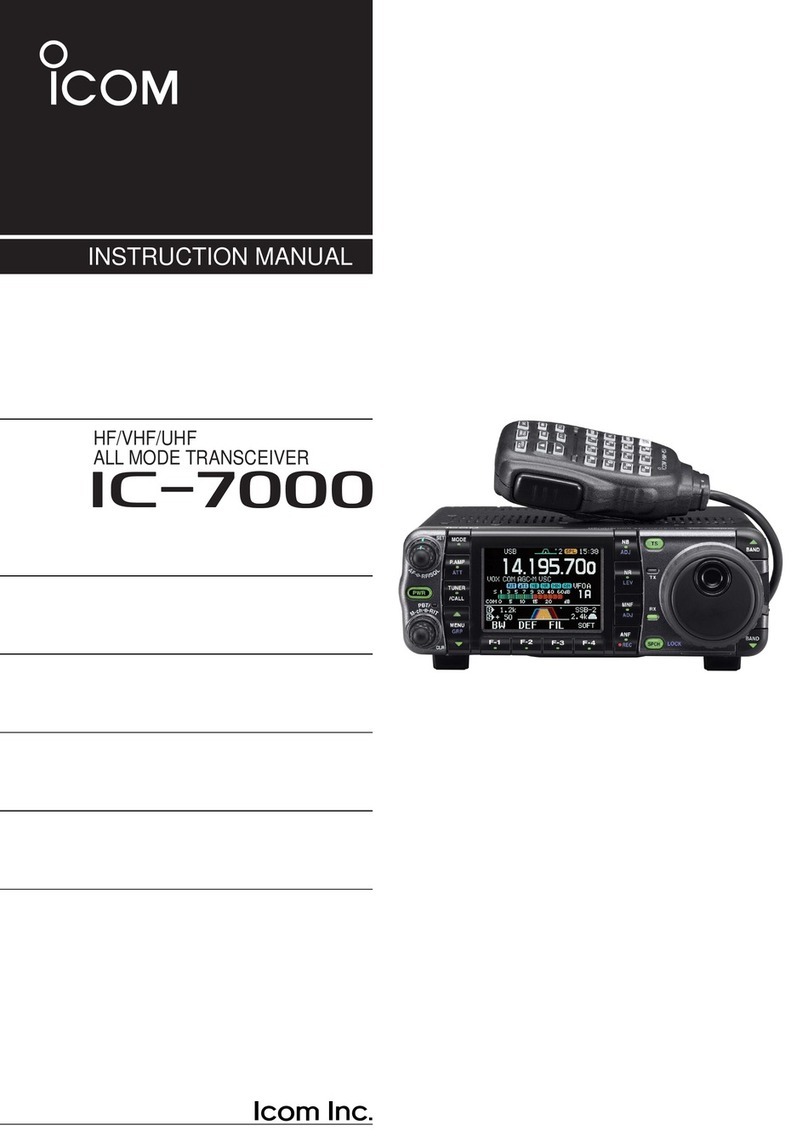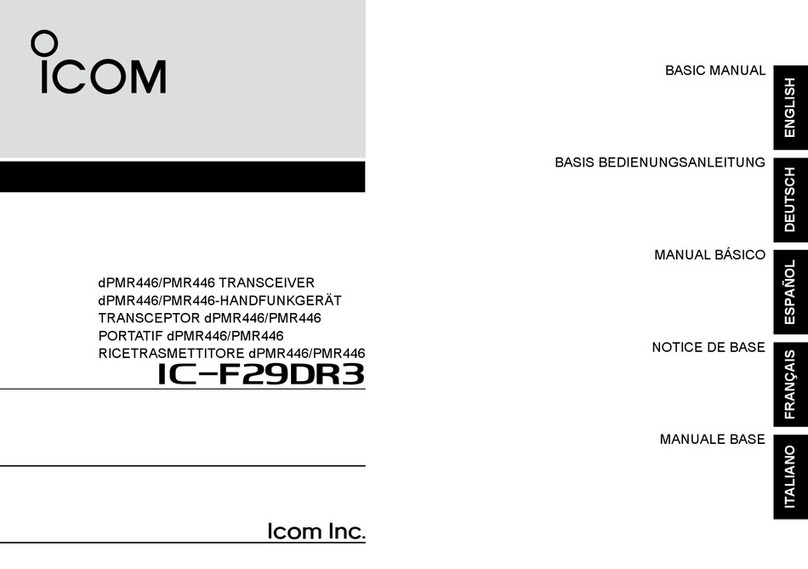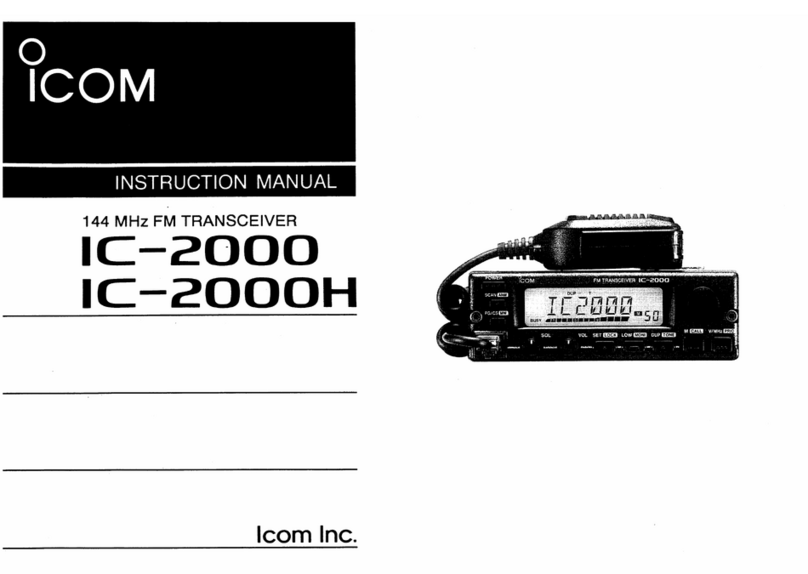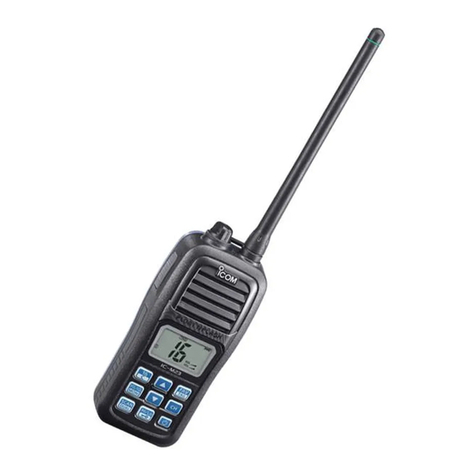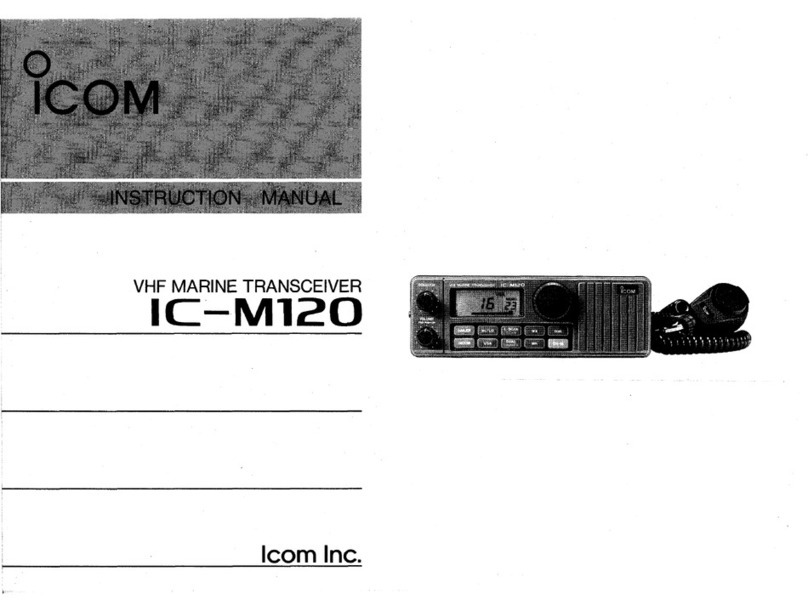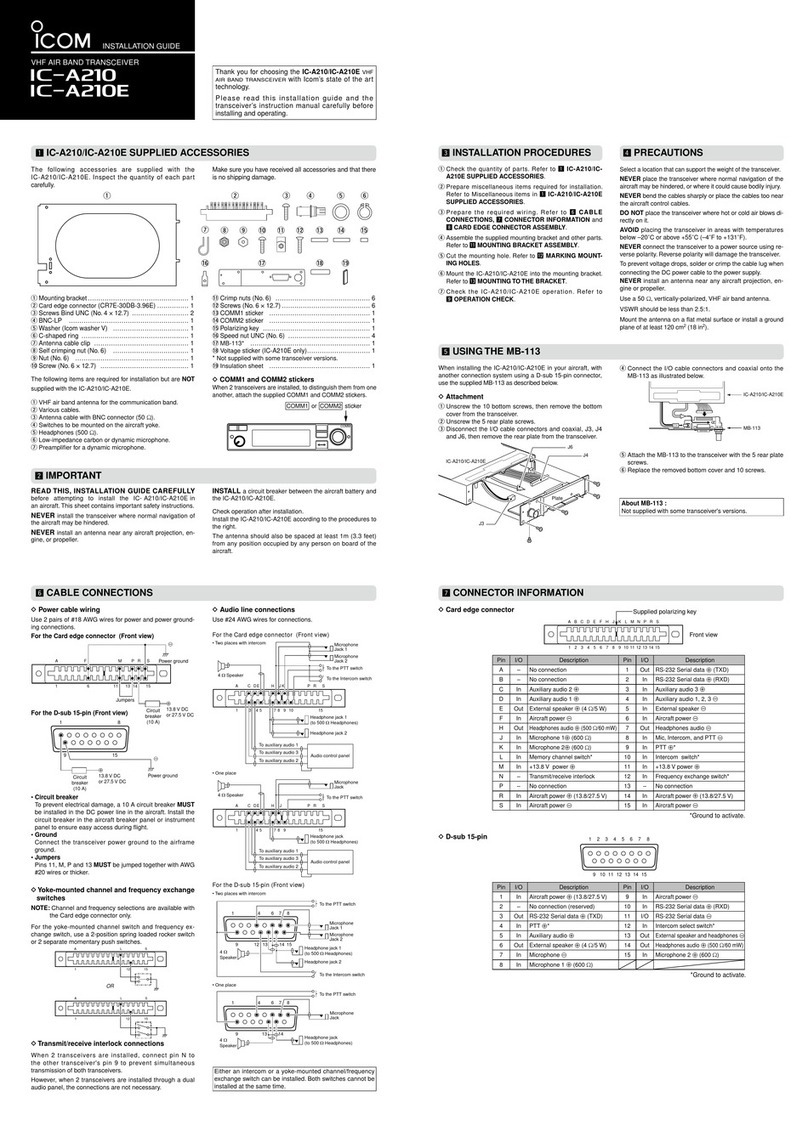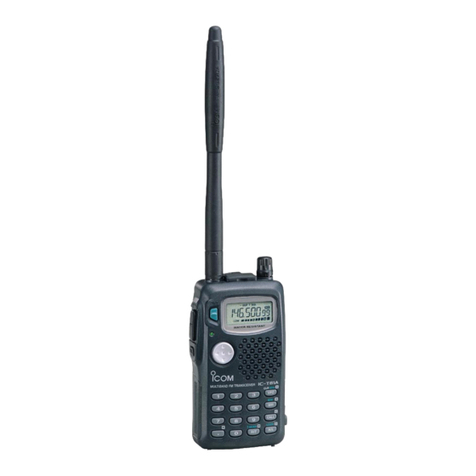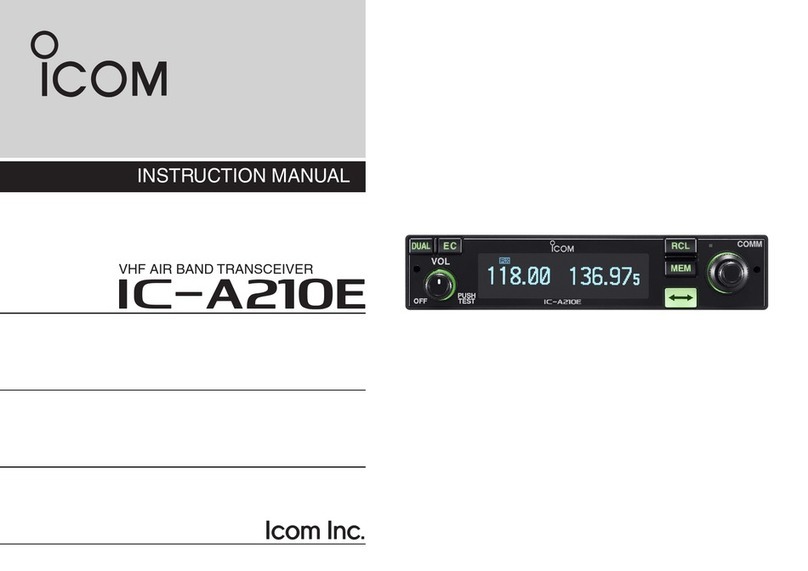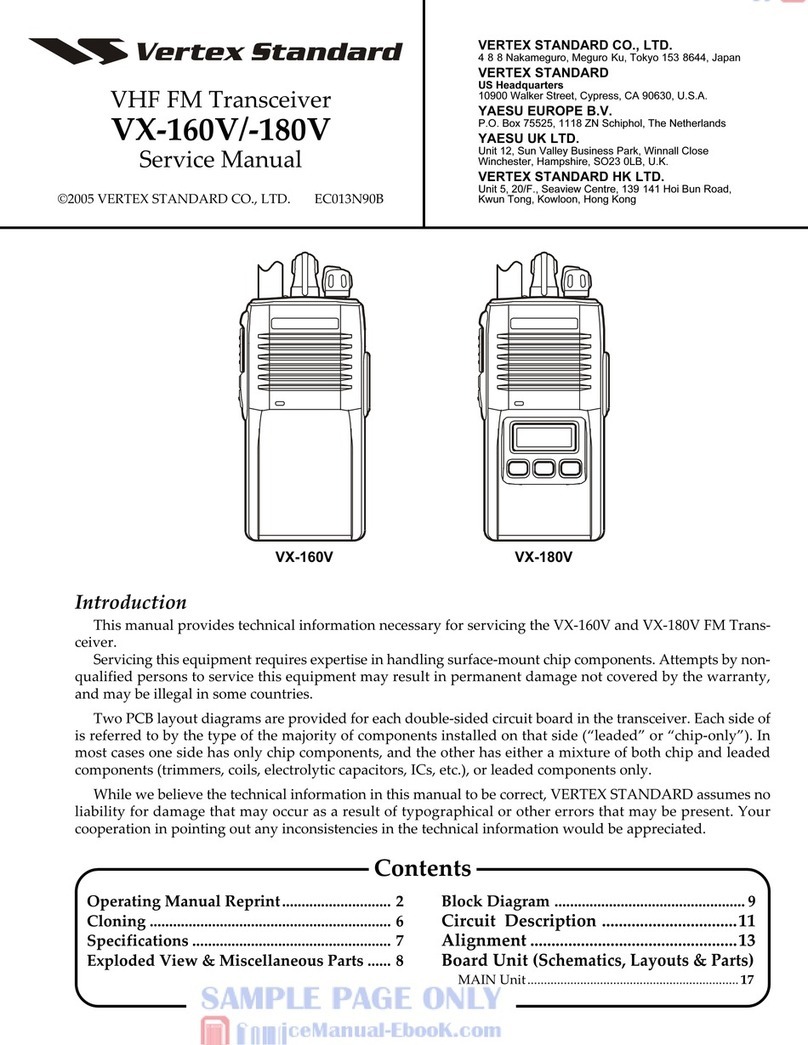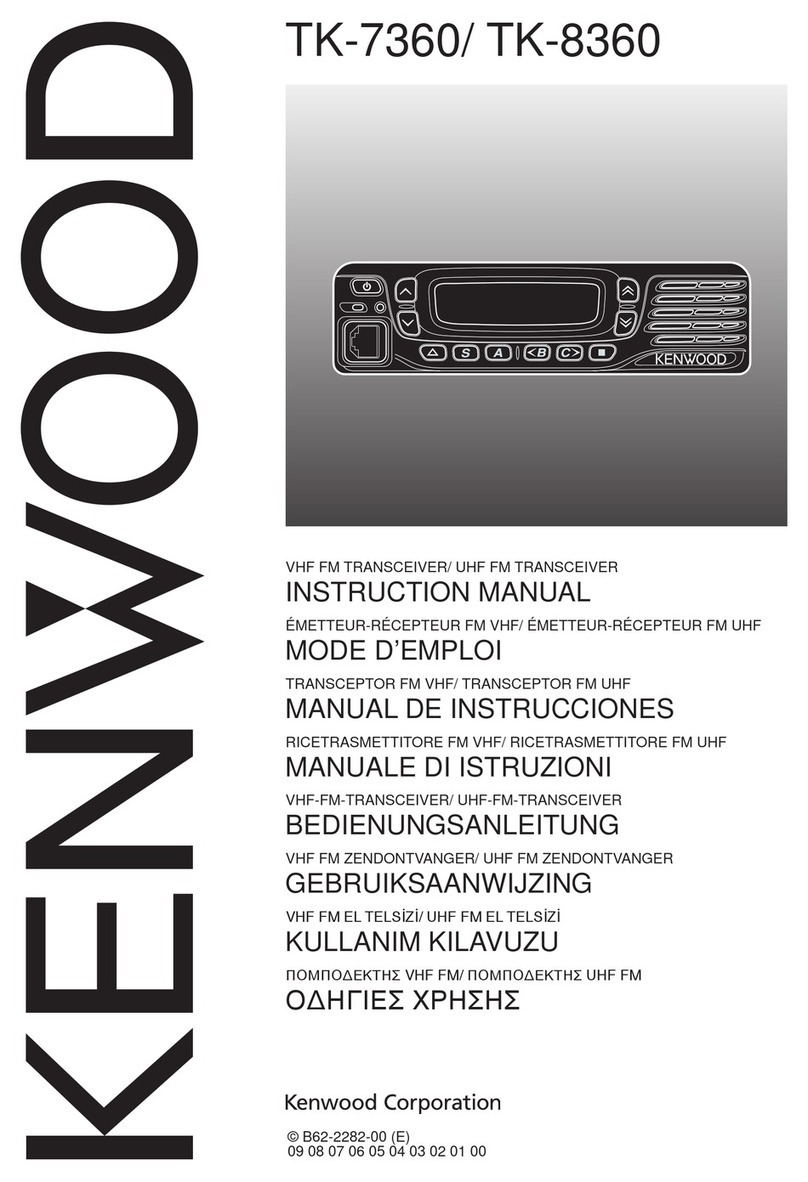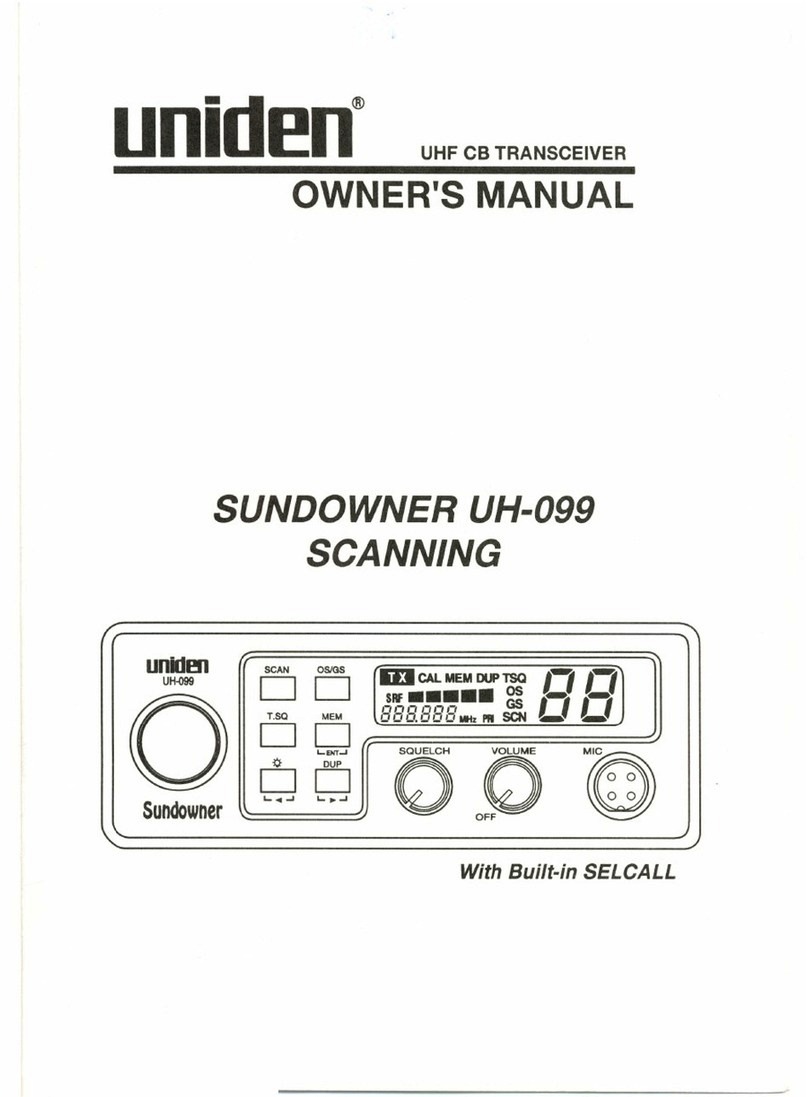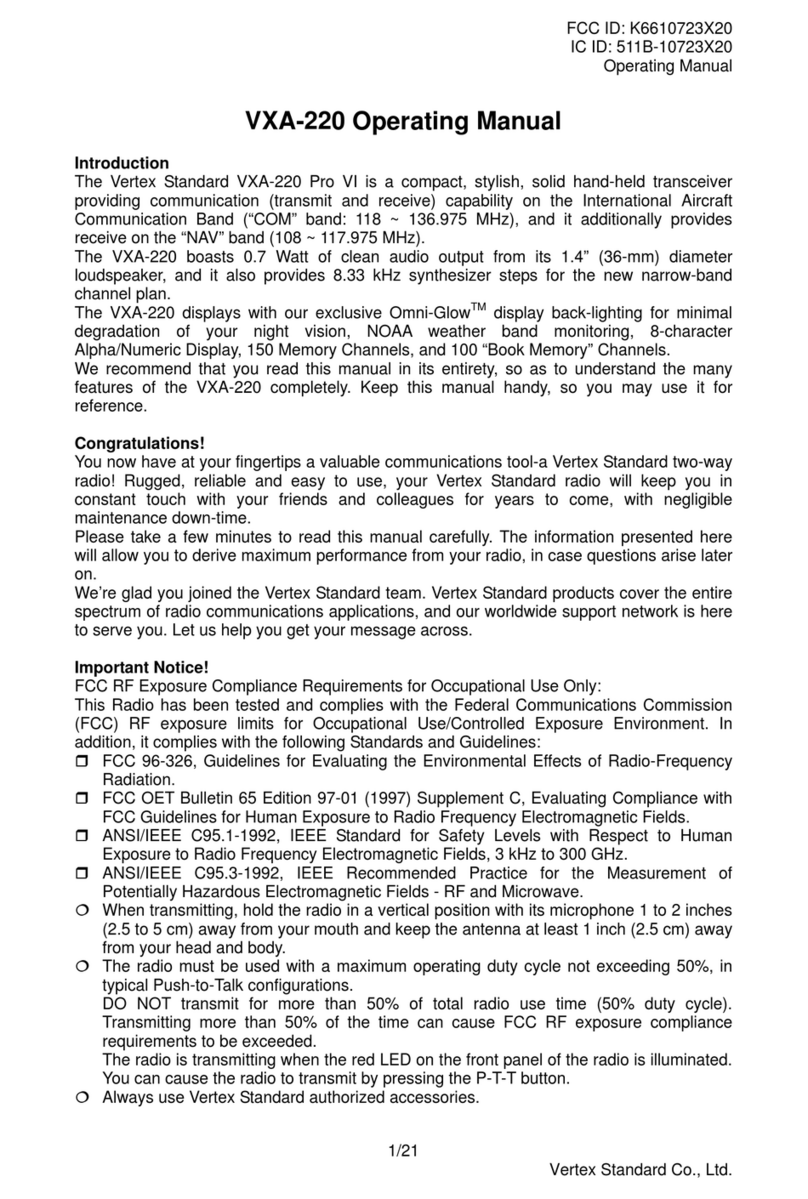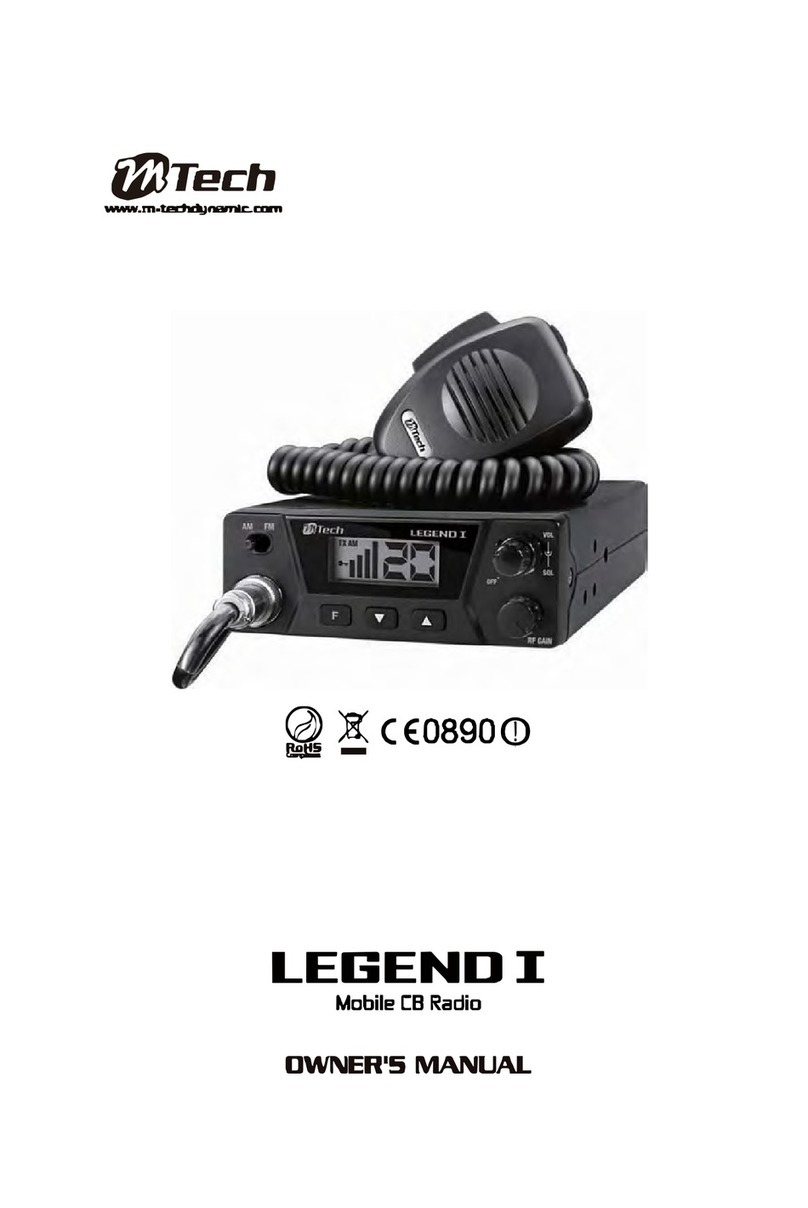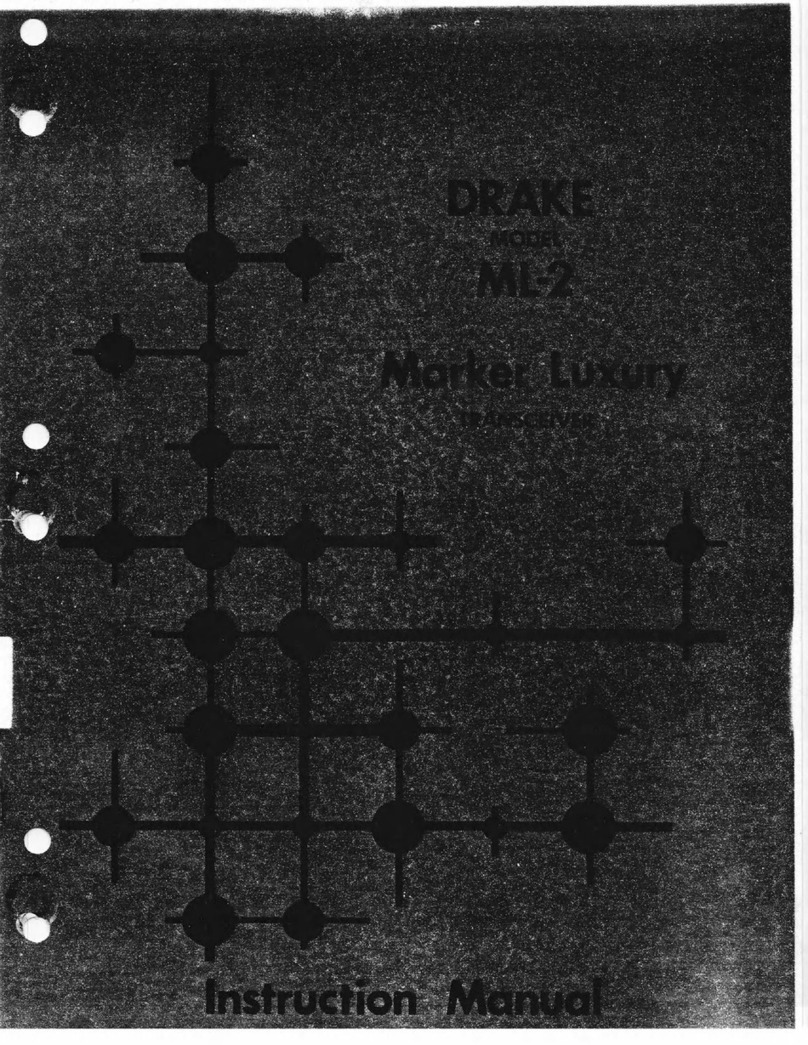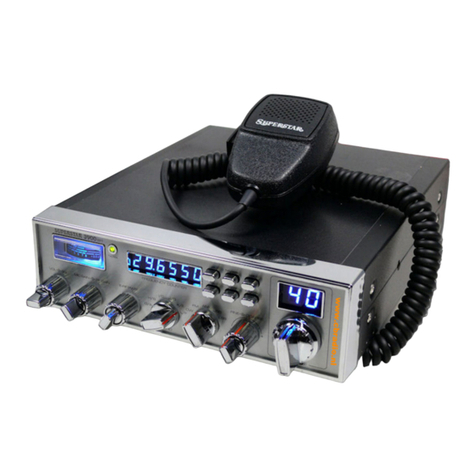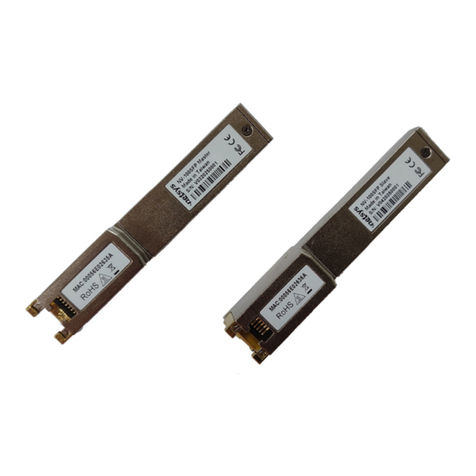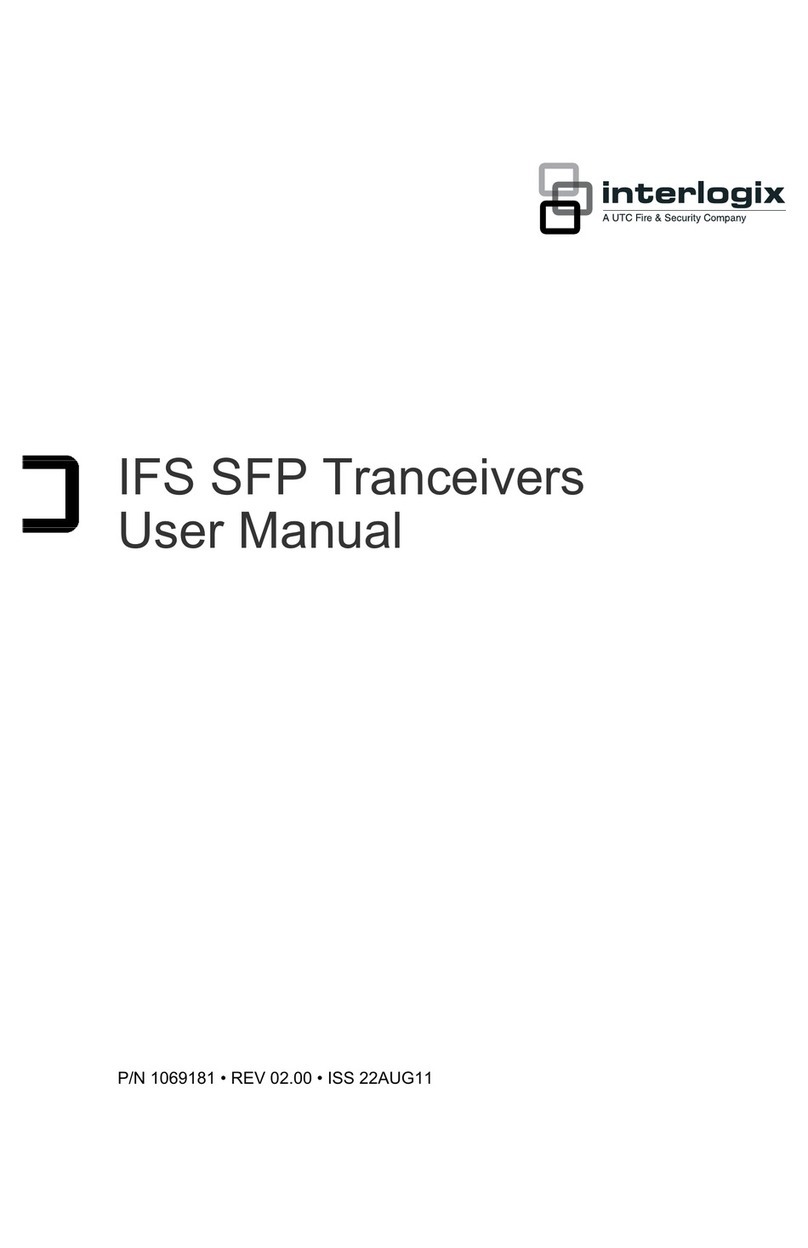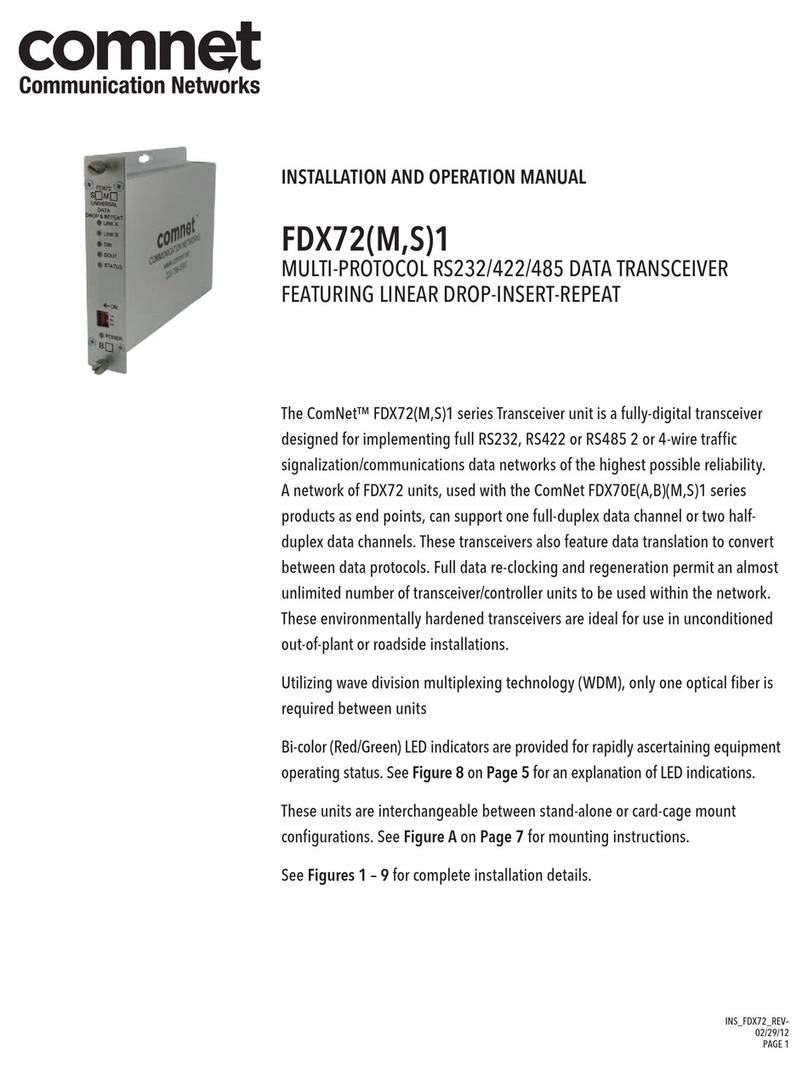Icom IC-GM651 User manual

INSTRUCTION MANUAL
New2001
iGM651
VHF MARINE TRANSCEIVER
Ver. 1.003

New2001
i
Thank you for purchasing this Icom transceiver. The
IC-GM651 vhf marine transceiver is designed and built
with Icom’s state of the art technology and craftsmanship.
With proper care, this transceiver should provide you with
years of trouble-free operation.
We want to take a couple of moments of your time to thank
you for making the IC-GM651 your radio of choice, and hope
you agree with Icom’s philosophy of “technology first.” Many
hours of research and development went into the design of
your IC-GM651.
DFEATURES
mBuilt-in DSC meets ITU Class A requirement
with PS-250 dc-dc power supply
mRugged waterproof construction
mLarge LCD with dot matrix characters
mMicrophone (to front panel) and Handset (to
rear panel) connections
READ ALL INSTRUCTIONS carefully and completely
before using the transceiver.
SAVE THIS INSTRUCTION MANUAL — This in-
struction manual contains important operating instructions
for the IC-GM651.
EXPLICIT DEFINITIONS
WORD DEFINITION
RWARNING Personal injury, fire hazard or electric
shock may occur.
CAUTION Equipment damage may occur.
NOTE
If disregarded, inconvenience only. No risk
of personal injury, fire or electric shock.
CLEAN THE TRANSCEIVER AND MICROPHONE
THOROUGHLY WITH FRESH WATER after exposure to
water including salt, otherwise, the keys and switch may
become inoperable due to salt crystallization.
Icom, Icom Inc. and the logo are registered trademarks of Icom
Incorporated (Japan) in the United States, the United Kingdom, Germany,
France, Spain, Russia and/or other countries.
IBM is a registered trademark of International Business Machines.
FOREWORD IMPORTANT

RWARNING! NEVER connect the transceiver to an
AC outlet. This may pose a fire hazard or result in an electric
shock.
NEVER connect the transceiver to an external DC power
supply directly. The transceiver should be connected to the
DC power supply through the PS-250 (input voltage: 10.8
to 31.2 V DC) that is sold by the set with this transceiver. Be
sure to not connect with reverse polarity.
NEVER cut the DC power cable between the DC plug and
fuse holder. If an incorrect connection is made after cutting,
the transceiver may be damaged.
NEVER place the transceiver where normal operation of
the vessel may be hindered or where it could cause bodily
injury.
KEEP the transceiver at least 1 m away from the ship’s
navigation compass.
DO NOT use or place the transceiver in areas with tem-
peratures below –15°C or above +55°C or, in areas subject
to direct sunlight, such as the dashboard.
DO NOT use the chemical agents such as benzine or al-
cohol when cleaning, as they may damage the transceiver
surfaces. If the transceiver becomes dusty or dirty, wipe it
clean with a soft, dry cloth.
BE CAREFUL! The transceiver rear panel will become
hot when operating continuously for long periods.
Place the transceiver in a secure place to avoid inadvertent
use by children.
BE CAREFUL! The transceiver employs waterproof con-
struction, which correspond to IPX7 of the international stan-
dard IEC 60529 (2001). However, once the transceiver have
been dropped, waterproofing cannot be guaranteed due to
the fact that the case may be cracked, or the waterproof seal
damaged, etc.
Icom optional equipment is designed for optimal perfor-
mance when used with this transceiver. We are not respon-
sible for the transceiver being damaged or any accident
caused when using non-Icom optional equipment.
ii
PRECAUTIONS

iii
New2001
If your vessel requires assistance, contact other vessels and
the Coast Guard by sending a Distress call on Channel 16.
USING CHANNEL 16
DISTRESS CALL PROCEDURE
1. “MAYDAY MAYDAY MAYDAY.”
2. “THIS IS ...............” (name of vessel).
3. Say your call sign or other indication of the vessel (AND
9-digit DSC ID if you have one).
4. “LOCATED AT ...............” (your position).
5. State the nature of the distress and assistance required.
6. Give any other information which might facilitate the
rescue.
Or, transmit your Distress call using digital selective calling
on Channel 70.
USING DIGITAL SELECTIVE CALLING (Ch 70)
DISTRESS CALL PROCEDURE
1. While l i f t i n g u p t he key c o ver, p u s h a n d h o l d
[DISTRESS] for 3 sec. until you hear 3 short beeps
change to one long beep.
2. Wait for an acknowledgment on Channel 70 from a
coast station.
• After the acknowledgement is received, Channel 16 is auto-
matically selected.
3. Push and hold [PTT], then transmit the appropriate
information as listed above.
The installation of this equipment should be made in such a
manner as to respect the EC recommended electromagnetic
field exposure limits (1999/519/EC).
The maximum RF power available from this device is 25
watts. The antenna should be installed as high as possible
for maximum efficiency and that this installation height
should be at least 5 meters above ground (or accessible)
level. In the case where an antenna cannot be installed at
a reasonable height, then the transmitter should neither be
continuously operated for long periods if any person is within
5 meters of the antenna, nor operated at all if any person is
touching the antenna.
In all cases any possible risk depends on the transmitter
being activated for long periods. (actual recommendation
limits are specified as an average of 6 minutes) Normally the
transmitter is not active for long periods of time. Some radio
licenses will require that a timer circuit automatically cuts the
transmitter after 1–2 minutes etc.
Similarly some types of transmitter, SSB, CW, AM, etc. have
a lower ‘average’ output power and the perceived risk is even
lower.
IN CASE OF EMERGENCY INSTALLATION NOTE

iv
New2001
FIRMWARE VERSION NUMBER
The firmware version number is displayed in the opening screen
as below.
The version number is also displayed when MMSI code check
screen is selected. (see p. 18)
IC-GM651
<MMSI>
123456789
Ver1.000
Firmware version number indication
(This illustration describes ‘Version 1.000’.)

v
New2001
FOREWORD ..................................................................................... i
IMPORTANT...................................................................................... i
EXPLICIT DEFINITIONS................................................................... i
PRECAUTIONS................................................................................ ii
IN CASE OF EMERGENCY............................................................ iii
INSTALLATION NOTE ..................................................................... iii
FIRMWARE VERSION NUMBER.................................................... iv
TABLE OF CONTENTS.................................................................... v
1 OPERATING RULES ..................................................................1
D PRIORITIES ............................................................................1
D PRIVACY .................................................................................1
D RADIO LICENSES ..................................................................1
2 PANEL DESCRIPTION ........................................................... 2–6
n Panel description .....................................................................2
n Function display.......................................................................5
3 BASIC OPERATION .............................................................7–13
n Channel selection ....................................................................7
D Channel 16 ..........................................................................7
D Call channel.........................................................................7
D International channels (Depends on version) ......................8
n Receiving and transmitting ......................................................8
n Call channel programming.....................................................10
n Channel comments................................................................11
n Microphone lock function.......................................................12
n Printer function ......................................................................12
n Backlight function...................................................................13
n AquaQuake water draining function.......................................13
4 DUALWATCH/TRI-WATCH ....................................................... 14
n Description.............................................................................14
n Operation...............................................................................14
5 SCAN OPERATION ............................................................15–17
n Scan types.............................................................................15
n Setting TAG channels ............................................................16
n Starting a scan.......................................................................16
6 DSC OPERATION.............................................................18–105
n MMSI code programming ......................................................18
n DSC address ID.....................................................................19
D Programming Individual ID ................................................19
D Deleting Individual ID.........................................................22
D Programming Group ID......................................................23
D Deleting Group ID..............................................................26
n Position and Time programming ............................................ 27
n Position and Time indication ..................................................30
n GPS information indication ....................................................31
n Distress call ...........................................................................32
D Simple call .........................................................................32
D Regular call........................................................................34
D Transmitting a Distress Cancel ..........................................38
D Transmitting a Distress Acknowledgement call ..................39
D Transmitting a Distress Relay call ......................................41
D Transmitting a Distress Relay Acknowledgement call........48
TABLE OF CONTENTS

vi
New2001
n Transmitting DSC calls...........................................................50
D Transmitting an All Ships call .............................................50
D Transmitting an Individual call............................................52
D Transmitting an Individual Acknowledgement call..............54
D Transmitting a Group call ...................................................60
D Transmitting a Position Request call ..................................62
D Transmitting a Position Reply call ......................................64
D Transmitting a Polling Reply call ........................................67
D Transmitting a Medical Transports call ...............................69
D Transmitting a Neutral Ship call .........................................70
D Transmitting a Test call.......................................................72
D Transmitting a Test Acknowledgement call.........................74
n Receiving DSC calls ..............................................................75
D Receiving a Distress call....................................................75
D Receiving a Distress Acknowledgement call .....................77
D Receiving a Distress Cancel..............................................78
D Receiving a Distress Relay call .........................................79
D Receiving a Distress Relay Acknowledgement call ...........80
D Receiving an All Ships call.................................................81
D Receiving an Individual call ...............................................82
D Receiving an Individual Acknowledgement call .................83
D Receiving a Group call.......................................................86
D Receiving a Position Request call......................................87
D Receiving a Position Reply call..........................................88
D Receiving a Polling Request call........................................89
D Receiving a Test call ..........................................................90
D Receiving a Test Acknowledgement call............................91
n Received messages ..............................................................92
D Distress message ..............................................................92
D Other messages ................................................................95
n DSC Set mode.......................................................................99
D Printing out the DSC memory contents .............................99
D Position Automatic Acknowledgement .............................100
D DSC Data Output.............................................................101
D Squelch Level Setting for Channel 70 Receiver............... 102
D
Medical Transports item Appearance in DSC Set up menu
...103
D
Neutral Ship Call item Appearance in DSC Set up menu
...104
D Self Check Testing ...........................................................105
7 SET MODE......................................................................106–108
n Set mode programming .......................................................106
n Set mode items....................................................................107
D Scan type.........................................................................107
D Scan resume timer...........................................................107
D Beep tone ........................................................................107
D Internal speaker...............................................................107
D Display contrast ...............................................................108
D Microphone type ..............................................................108
D Cursor
➔
(Downward) movement ...................................108
TABLE OF CONTENTS

vii
New2001
8 CONNECTIONS AND MAINTENANCE..........................109–117
n Connections.........................................................................109
n Antenna ...............................................................................110
n Fuse replacement................................................................110
n Supplied accessories...........................................................111
D Accessory connectors set up...........................................111
n Power supply connections ...................................................112
D
Connecting to the DC power supply through the PS-250
...112
D Connecting to the AC outlet through the PS-250
and optional PS-240 ........................................................113
n Mounting the transceiver .....................................................114
D Using the supplied mounting bracket...............................114
n MB-75 installation ................................................................115
n Microphone (HM-126RB).....................................................116
D Connection.......................................................................116
n Handset (HS-98)..................................................................117
D Connection.......................................................................117
9 TROUBLESHOOTING ............................................................118
10 SPECIFICATIONS AND OPTIONS.................................119–120
n Specifications.......................................................................119
D General............................................................................119
D Transmitter .......................................................................119
D Receiver...........................................................................119
D Dimensions......................................................................120
n Options ................................................................................120
11 CHANNEL LIST ......................................................................121
New2001
TABLE OF CONTENTS (Continued)

1
1
OPERATING RULES
New2001
1
2
3
4
5
6
7
8
9
10
11
12
13
14
15
16
DPRIORITIES
• Read all rules and regulations pertaining to priorities and
keep an up-to-date copy handy. Safety and Distress calls
take priority over all others.
• You must monitor Channel 16 when you are not operating
on another channel.
• False or fraudulent distress signals are prohibited and pun-
ishable by law.
DPRIVACY
• Information overheard but not intended for you cannot law-
fully be used in any way.
• Indecent or profane language is prohibited.
DRADIO LICENSES
(1) SHIP STATION LICENSE
You must have a current radio station license before using
the transceiver. It is unlawful to operate a ship station which
is not licensed.
Inquire through your dealer or the appropriate government
agency for a Ship-Radiotelephone license application. This
government-issued license states the call sign which is your
craft’s identification for radio purposes.
(2) OPERATOR’S LICENSE
A Restricted Radiotelephone Operator Permit is the license
most often held by small vessel radio operators when a radio
is not required for safety purposes.
The Restricted Radiotelephone Operator Permit must be
posted or kept with the operator. Only a licensed radio op-
erator may operate a transceiver.
However, non-licensed individuals may talk over a trans-
ceiver if a licensed operator starts, supervises, ends the call
and makes the necessary log entries.
Keep a copy of the current government rules and regulations
handy.

2
New2001New2001
PANEL DESCRIPTION
2
qCLEAR KEY [CLR]
Push to cancel the entered function, stop the scan, exit
Set mode, etc. (pgs. 14, 16, 106)
wFUNCTION KEY [F]
After pushing this key, some keys perform secondary
function.
• “F” appears when a secondary function can be accessed.
eDISTRESS KEY [DISTRESS] (pgs. 32, 36)
Push and hold for 3 sec. to transmit a Distress call.
rDSC MENU KEY [MENU•MMSI]
➥Push to toggle the DSC menu ON or OFF.
➥Push to enter the MMSI code programming condition
when no MMSI code is programmed. (p. 18)
➥Push and hold for 1 sec. to indicate the 9-digit MMSI
code and firmware version number.
VOL
iGM651
VHF MARINE
MIC
C
H/L
DIAL
16
SQL
MMSI
Speaker
Function display (p. 5)
qCLEAR KEY
iMIC CONNECTOR
tPOWER KEY
oVOLUME CONTROL
rDSC MENU KEY
eDISTRESS KEY
wFUNCTION KEY
!2 CHANNEL 16/
CALL CHANNEL KEY
!3 KEYPAD
!1 SELECTOR
DIAL
!0 TRANSMIT
POWER KEY
uSQUELCH CONTROL yDIAL KEY
VOL
SQL
POWER
H/L
DIAL
C
16
Rotate
SELECTOR
MMSI
nPanel description

3
2
PANEL DESCRIPTION
New2001
tPOWER KEY [POWER] (p. 8)
➥Push to turn power ON and OFF.
• The transceiver does not turn power ON when the connected
PC-250 dc-dc power supply is turned OFF.
• After turning power ON, the 9-digit MMSI code appears for 2
sec., if programmed.
• When no MMSI code is programmed, “NO MMSI” is dis-
played at power ON, and then the MMSI code programming
is required.
➥While pushing and holding [H/L], turn power ON to ac-
tivate the AquaQuake function. (p. 13)
➥While pushing and holding [⁄6•C], turn power ON to
enter Set mode. (p. 106)
yDIAL KEY [DIAL]
➥Push to select to the regular channel. (pgs. 7, 8)
➥While pushing and holding [H/L], push to select one of
three channel groups in sequence depending on ver-
sion. (p. 8)
• EUR version has International channels only and this func-
tion is not available.
uSQUELCH CONTROL [SQL] (p. 8)
Rotate to set the squelch threshold level.
iMIC CONNECTOR
Connect the optional hand microphone only. (p. 116)
CAUTION: NEVER connect the optional handset
(HS-98) here.
oVOLUME CONTROL [VOL] (p. 8)
Rotate to adjust the audio level.
!0 TRANSMIT POWER KEY [H/L]
➥Push to toggle the output power high or low. (p. 8)
• Some channels are set to low power only.
➥While pushing and holding this key, some keys perform
secondary functions.
!1 SELECTOR DIAL [SELECTOR] (pgs. 7, 8, 106)
Rotate to select the operating channels, set mode con-
tents, etc.
!2 CHANNEL 16/CALL CHANNEL KEY [⁄6•C]
➥Push to select Channel 16. (p. 7)
➥Push and hold for 1 sec. to select call channel. (p. 7)
• “CALL” appears when call channel is selected.
➥Push and hold for 3 sec. to enter call channel program-
ming condition when call channel is selected. (p. 10)
!3 KEYPAD
➥Inputs numeral for channel number input, etc.
• After inputting the desired channel number, push [ENT].
• Push and hold [0•A]to input ‘A’ for simplex channels.
➥Inputs numeral, alphabet and some symbols for chan-
nel comment input.
➥
After pushing [F], push to perform the secondary function.
• Most of secondary function (except TAG channel setting;
p. 16, print out operation; p. 12) can be cleared or cancelled
when [CLR] is pushed.
1
2
3
4
5
6
7
8
9
10
11
12
13
14
15
16

4
2PANEL DESCRIPTION
New2001
➥Number input: ‘1’
➥Comment input: ‘Q,’ ‘Z,’ ‘q,’ ‘z’ or space
➥After pushing [F], push to turn the Dualwatch
function ON or OFF. (p. 14)
➥Number input: ‘2’
➥Comment input: ‘A,’ ‘B,’ ‘C’ ‘a,’ ‘b’ or ‘c’
➥After pushing [F], push to turn the Tri-watch
function ON or OFF. (p. 14)
➥Number input: ‘3’
➥Comment input: ‘D,’ ‘E,’ ‘F,’ ‘d,’ ‘e’ or ‘f’
➥After pushing [F], push this key then rotate
[SELECTOR] to adjust the brightness of the
LCD and key backlight. (p. 13)
➥Number input: ‘4’
➥Comment input: ‘G,’ ‘H,’ ‘I,’ ‘g,’ ‘h’ or ‘i’
➥After pushing [F], push to start or stop the scan
function. (p. 16)
➥Number input: ‘5’
➥Comment input: ‘J,’ ‘K,’ ‘L,’ ‘j,’ ‘k’ or ‘l’
➥After pushing [F], push to set the displayed
channel as a TAG channel. (p. 16)
➥While pushing and holding [H/L], push for 3 sec.
to clear or set all TAG channels. (p. 16)
➥Number input: ‘6’
➥Comment input: ‘M,’ ‘N,’ ‘O,’ ‘m,’ ‘n’ or ‘o’
➥Number input: ‘7’
➥Comment input: ‘P,’ ‘R,’ ‘S,’ ‘p,’ ‘r’ or ‘s’
➥Number input: ‘8’
➥Comment input: ‘T,’ ‘U,’ ‘V,’ ‘t,’ ‘u’ or ‘v’
➥After pushing [F], push to transfer the received
DSC data to the printer. (p. 12)
➥Number input: ‘9’
➥Comment input: ‘W,’ ‘X,’ ‘Y,’ ‘w,’ ‘x’ or ‘y’
➥After pushing [F], push to indicate the received
message log. (pgs. 92, 95)
➥Number input: ‘0’
➥Number input: Push and hold for 1 sec. to input
‘A’ for simplex channel.
➥Comment input: ‘0’ and symbols (‘–’ ‘/’ ‘.’)
➥Push to enter the input channel comment, se-
lected item, etc.
➥Push to clear the entered data.

5
2
PANEL DESCRIPTION
New2001
qCALL CHANNEL INDICATOR (pgs. 7, 10)
Appears when the call channel is selected.
wMESSAGE INDICATOR (pgs. 33, 75, 92)
Blinks when the unread message is stored in the Call Log
memory.
eCHANNEL NUMBER READOUT
Indicates the selected operating channel number.
rCHANNEL COMMENT INDICATOR
Channel comment appears if programmed. (p. 11)
1
2
3
4
5
6
7
8
9
10
11
12
13
14
15
16
nFunction display
BUSY 25W INT CALL
DUP
TAG
NORMAL SCAN
34°34.506N
123°23.236W
UTC 1:10 CALLING
!1 DUPLEX INDICATOR
uSCAN INDICATOR
wMESSAGE
INDICATOR
eCHANNEL NUMBER
READOUT
rCHANNEL COMMENT
INDICATOR
tTIME ZONE
INDICATOR
yPOSITION
INDICATOR
oBUSY/TRANSMIT
INDICATOR
iTAG CHANNEL
INDICATOR
qCALL CHANNEL
INDICATOR
!2 CHANNEL GROUP
INDICATOR
!0 POWER
INDICATOR

6
2PANEL DESCRIPTION
New2001
tTIME ZONE INDICATOR
➥Shows the current time data when a GPS receiver is
connected.
• “??” and the last received time data may blink alternately
every 2 sec. instead of current time data when the GPS cur-
rent time data is invalid.
• “??” and the last received time data may blink alternately
every 2 sec. instead of current time data 4 hours after the
time data is input manually, up until 23.5 hours have past.
➥ “No Time” appears when no GPS receiver is con-
nected and no time data is input manually.
➥
“ ” a
ppears when a GPS receiver is connected.
yPOSITION INDICATOR
➥ Shows the GPS position data.
• “??” and the last received position data may blink alternately
every 2 sec. instead of position data when the GPS position
data is invalid. In such a case, the last position data is held
for up to 23.5 hours.
• “??” and the last received position data may blink alternately
every 2 sec. instead of position data 4 hours after the posi-
tion data is input manually, up until 23.5 hours have past.
➥ “No Position” appears when no GPS receiver is
connected and no position data is input manually.
uSCAN INDICATOR
➥“PRI-SCAN 16” appears during Priority scan;
“NORMAL SCAN” appears during Normal scan.
(p. 16)
➥“DUAL 16” appears during Dualwatch; “TRI 16” ap-
pears during Tri-watch. (p. 14)
iTAG CHANNEL INDICATOR (p. 16)
Appears when a TAG channel is selected.
oBUSY/TRANSMIT INDICATOR
➥“BUSY” appears when receiving a signal or when the
squelch opens. (p. 8)
➥“TX” appears while transmitting. (p. 9)
!0 POWER INDICATOR (p. 8)
➥“25W” appears when high power is selected.
➥“1W” appears when low power is selected.
!1 DUPLEX INDICATOR (p. 8)
Appears when a duplex channel is selected.
!2 CHANNEL GROUP INDICATOR (p. 8)
Indicates when an International “INT” channel is in use.
(Depends on version)
New2001

7
3
BASIC OPERATION
New2001
1
2
3
4
5
6
7
8
9
10
11
12
13
14
15
16
nChannel selection
DChannel 16
Channel 16 is the distress and safety channel. It is used for
establishing initial contact with a station and for emergency
communications. Channel 16 is monitored during both Du-
alwatch and Tri-watch. While standing by, you must monitor
Channel 16.
qPush [⁄6•C] momentarily to select Channel 16.
25W INT
TAG
34°34.506N
123°23.236W
UTC 12:00 CALLING
[⁄6•C] [H/L] [DIAL]
[SELECTOR]
KEYPAD
[CE]
[CLR] [F]
[4• ]
[ENT] [MENU•MMSI]
Push
C
16
wPush [DIAL] to return to the condition before selecting
Channel 16, or rotate [SELECTOR] to select a channel.
• Pushing the keypad or [Y]/[Z]on the microphone also selects
a channel.
DCall channel
Each regular channel group has a separate leisure-use call
channel. The call channel is monitored during Tri-watch. The
call channels can be programmed (p. 10) and are used to
store your most often used channel in each channel group
for quick recall.
qPush and hold [⁄6•C] for 1 sec. to select the call channel
of the selected channel group.
• “CALL” and call channel number appear.
• Each channel group may have an independent call channel
after programming a call channel. (p. 10)
25W INT CALL
TAG
34°34.506N
123°23.236W
UTC 12:00 CALLING
Appears
Push and hold
C
16
for 1 sec.
wPush [DIAL] to return to the condition before selecting
call channel, or rotate [SELECTOR] to select a channel.
• Pushing the keypad or [Y]/[Z]on the microphone also selects
a channel.

DInternational channels (Depends on version)
There are pre-programmed 57 international channels for the
IC-GM651.
qPush [DIAL] to select a regular channel.
wWhile pushing and holding [H/L], push [DIAL] to change
the channel group, if necessary.
• “INT” appears when International channel is selected.
25W INT
DUP
TAG
34°34.506N
123°23.236W
UTC 12:00 PORT OPR
Appears
H/L
DIAL
Push +
eRotate [SELECTOR] to select a channel.
• “DUP” appears for duplex channels.
• Pushing the keypad or [Y]/[Z]on the microphone also selects
a channel.
nReceiving and transmitting
CAUTION: Transmitting without an antenna will dam-
age the transceiver.
qPush [POWER] to turn power ON.
• After turning power ON, the 9-digit MMSI code appears for 2
sec. (If no MMSI code is programmed, “NO MMSI” appears
and the MMSI programming is required; p. 18)
• The transceiver does not turn power ON when the connected
PC-250 dc-dc power supply is turned OFF.
wSet the audio and squelch levels.
➥Rotate [SQL] fully counterclockwise in advance.
➥Rotate [VOL] to adjust the audio output level.
➥Rotate [SQL] clockwise until the noise disappears.
eWhile pushing and holding [H/L], push [DIAL] several
times to change the channel group. (p. 8)
rRotate [SELECTOR] to select a channel. (pgs. 7, 8, 121)
• Pushing the keypad or [Y]/[Z]on the microphone also selects
a channel.
• When receiving a signal, “BUSY” appears and audio is emitted
from the speaker.
• Further adjustment of [VOL] may be necessary.
tPush [H/L] to select the output power if necessary.
• “25W” or “1W” appears when high or low power is selected, re-
spectively.
• Choose low power for short range communications, choose
high power for longer distance communications.
• Some channels are for low power only.
8
3BASIC OPERATION
New2001

9
3
BASIC OPERATION
New2001
1
2
3
4
5
6
7
8
9
10
11
12
13
14
15
16
yPush and hold [PTT] to transmit, then speak into the mi-
crophone.
• “TX” appears.
• Channel 70 cannot be used for transmission other than DSC.
uRelease [PTT] to receive.
IMPORTANT: To maximize the readability of your trans-
mitted signal, pause a few sec. after pushing [PTT], hold
the microphone 5 to 10 cm from your mouth and speak at
a normal voice level.
4NOTE for TOT (Time-out Timer) function
The TOT function inhibits continuous transmission over 5
minutes after the transmission starts.
A short beep sounds 10 seconds before the TOT function is
activated, and “TOT” blinks in the channel comment indicator.
When the TOT is activated, error beeps sound at normal vol-
ume while [PTT] is pushed.
• Transmission is not possible and “TIME OUT” appears in the
channel comment indicator for 10 sec. after this transmission shut
down.
VOL
MIC
C
16
SQL
Microphone
yTransmit
uReceive
qTurn power ON
rSelect a channel
wSet the audio
and squelch
levels
eChange the
channel group
rSelect a
channel
tSelect the
output power
rSelect a
channel
HM-126RB HS-98
eChange the
channel group
tSelect the
output power
(while pushing this
key, push [DIAL] on
the transceiver. )
When the optional HS-98 is used, the receiving audio is
emitted from the connected external speaker, or muted
depending on the speaker switch condition. See p. 117
for details.

10
3BASIC OPERATION
New2001
nCall channel programming
You can program the call channel with your most often-used
channels in each channel group for quick recall.
qWhile pushing and holding [H/L], push [DIAL] several
times to select the desired channel group to be pro-
grammed.
25W INT
DUP
TAG
34°34.506N
123°23.236W
UTC 12:00 INTL
H/L
DIAL
Push +
Appears
wPush and hold [⁄6•C] for 1 sec. to select the call channel
of the selected channel group.
• “CALL” and call channel number appear.
25W INT CALL
TAG
34°34.506N
123°23.236W
UTC 12:00 CALLING
Push and hold
C
16
for 1 sec.
Appears
e
Push and hold [⁄6•C] again for 3 sec. (until a long beep
changes to 2 short beeps) to enter call channel program-
ming condition.
• Channel number starts blinking.
25W INT CALL
TAG
34°34.506N
123°23.236W
UTC 12:00 CALLING
Push and hold
C
16
for 3 sec.
rRotate [SELECTOR] to select the desired channel.
25W INT CALL
DUP
TAG
34°34.506N
123°23.236W
UTC 12:00 INTL
Rotate
SELECTOR
tPush [⁄6•C] to program the displayed channel as the call
channel.
• Push [CLR] to cancel.
• The channel number stops blinking.
25W INT CALL
DUP
TAG
34°34.506N
123°23.236W
UTC 12:00 INTL
Push
C
16

11
3
BASIC OPERATION
New2001
1
2
3
4
5
6
7
8
9
10
11
12
13
14
15
16
nChannel comments
Memory channels can be labeled with a unique alphanu-
meric ID of up to 10 characters each.
Capital letters, small letters, 0 to 9, some symbols (- . /)
and space can be used.
qSelect the desired channel.
• Cancel Dualwatch, Tri-watch or Scan in advance.
wWhile pushing and holding [H/L], push [⁄6•C] to input the
channel comment.
• A cursor and the first character start blinking alternately.
25W INT
TAG
34°34.506N
123°23.236W
UTC 12:00PLEASURE__
H/L
Push +
C
16
1st character blinks
ePush the appropriate key several times to enter the de-
sired character.
• See the table at p. 12 for the available characters.
• Rotate [SELECTOR] or push [Y]/[Z]on the microphone to
move the cursor.
• Push [CE] to clear the channel comment.
• Push [CLR] to cancel and exit the condition.
Rotate
SELECTOR
25W INT
TAG
34°34.506N
123°23.236W
UTC 12:00SLEASURE__
Cursor moves
Push
CLR
25W INT
TAG
34°34.506N
123°23.236W
UTC 12:00SLEASURE__
Input the channel
comment
� To enter the space:
Push several times
until ‘_’ (under bar) appears.
25W INT
TAG
34°34.506N
123°23.236W
UTC 12:00SHIP______

12
3BASIC OPERATION
New2001
rPush [ENT] to input and set the comment.
• The cursor and the character stop blinking.
25W INT
TAG
34°34.506N
123°23.236W
UTC 12:00SHIP______
Push
25W INT
TAG
34°34.506N
123°23.236W
UTC 12:00 SHIP
tRepeat steps qto rto program other channel com-
ments, if desired.
• Available characters
KEY CHARACTERSKEY CHARACTERS
1 Q Z q z (space)
2 A B C a b c
3 D E F d e f
4 G H I g h i
5 J K L j k l
6 M N O m n o
7 P R S p r s
8 T U V t u v
9 W X Y w x y
0 - / .
nMicrophone lock function
The microphone lock function elec-
trically locks [Y]/[Z]and [HI/LO]
keys on the optional microphone.
This prevents accidental channel
changes and function access.
➥While pushing and holding
[HI/LO] on the microphone, turn
power ON to toggle the micro-
phone lock function ON and OFF.
nPrinter function
The received DSC call contents can be printed out when a
printer (IBM®centronics or compatible) is connected to the
transceiver.
➥After pushing [F], push [8• PRT ]to transfer the received
DSC call data or Address ID to the printer.
NOTE: The degree sign is converted to the period as
below when the DSC call data, included the position data,
is printed out.
The display contents The printout contents
LAT:-12°23.111N
➔LAT:-12.23.111N
[HI/LO]
[Y]/[Z]
Other manuals for IC-GM651
2
Table of contents
Other Icom Transceiver manuals
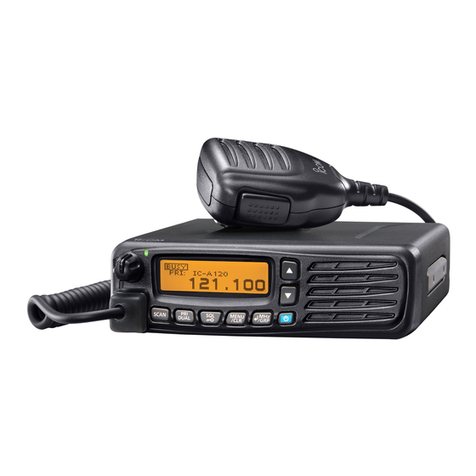
Icom
Icom IC-120 Installation instructions
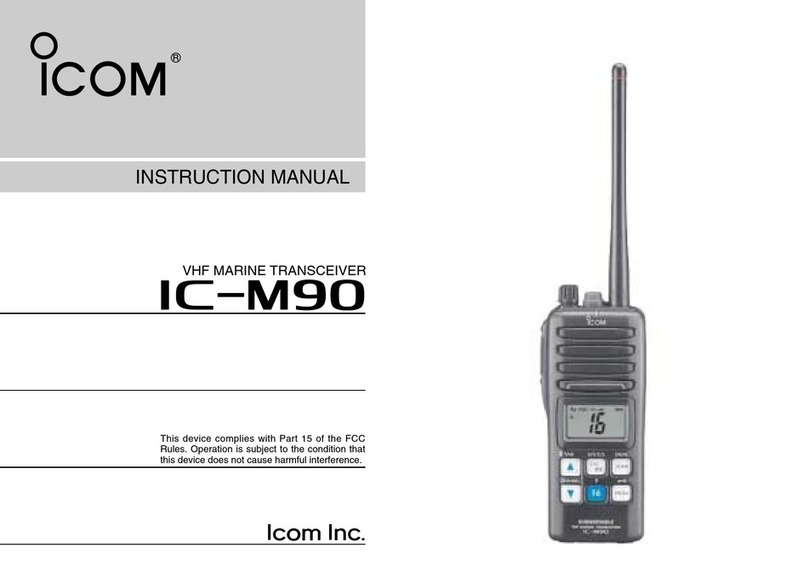
Icom
Icom IC-M90 User manual
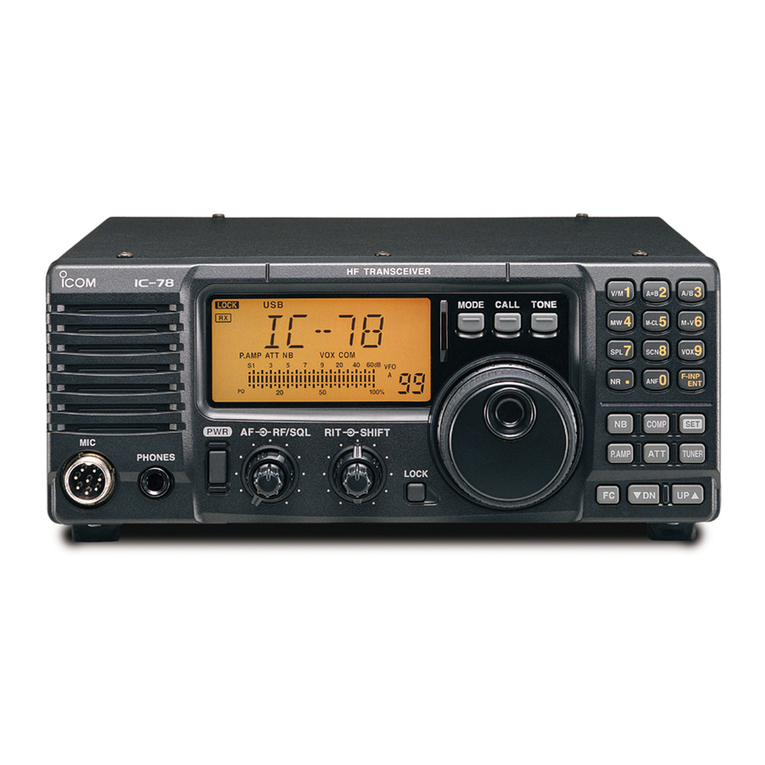
Icom
Icom IC-78 Assembly instructions
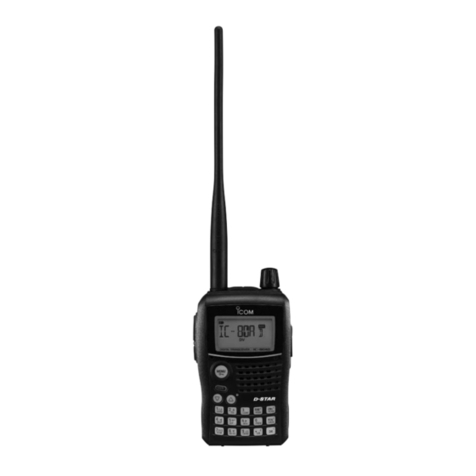
Icom
Icom IC-80AD User manual
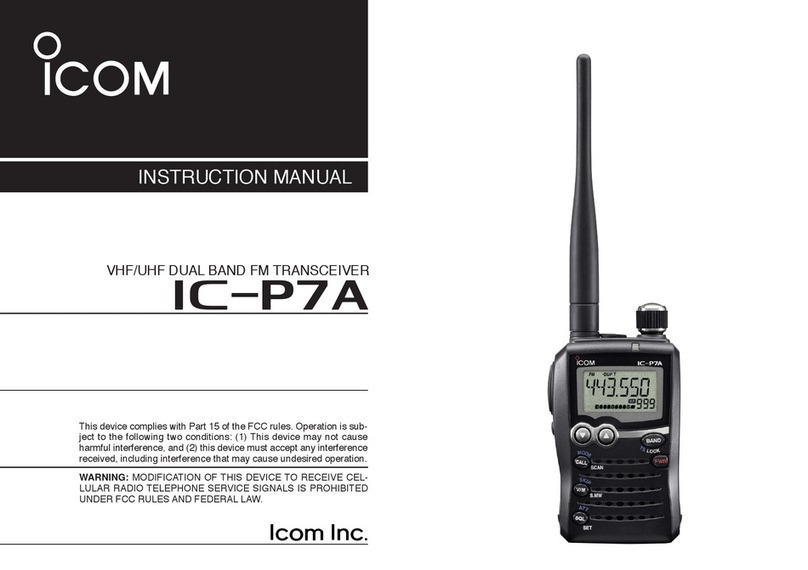
Icom
Icom IC-P7A User manual
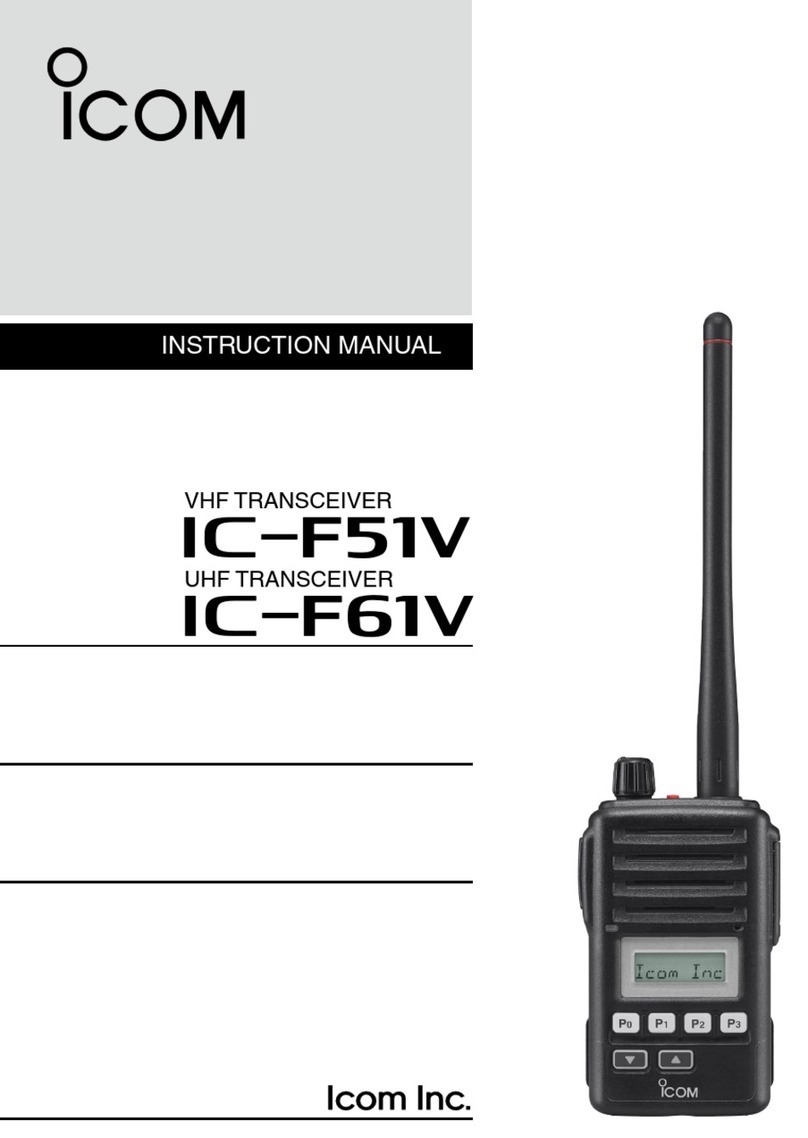
Icom
Icom IC-F51V User manual
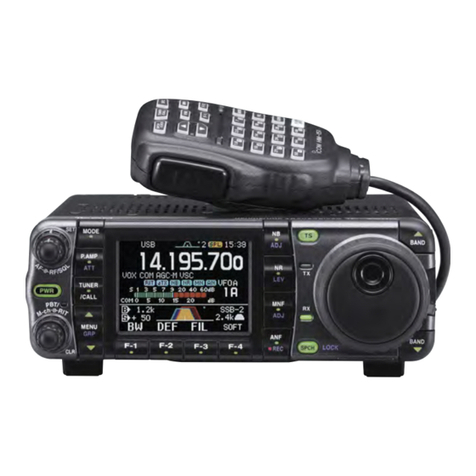
Icom
Icom IC-7000 Instruction Manual

Icom
Icom iC-F5012 User manual
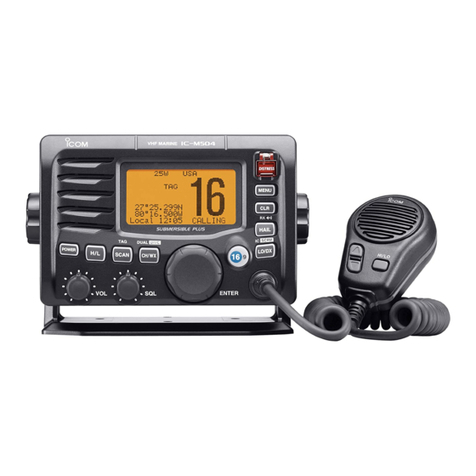
Icom
Icom IC-M504 User manual
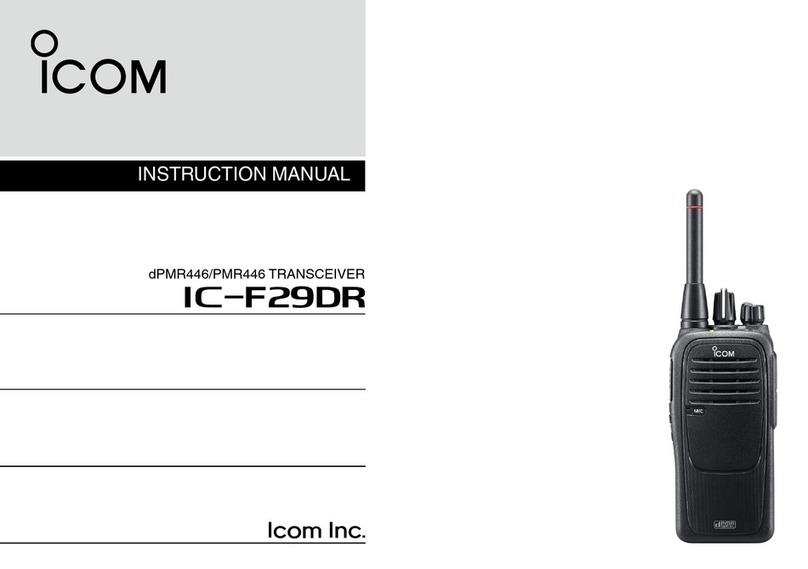
Icom
Icom iF29DR User manual
